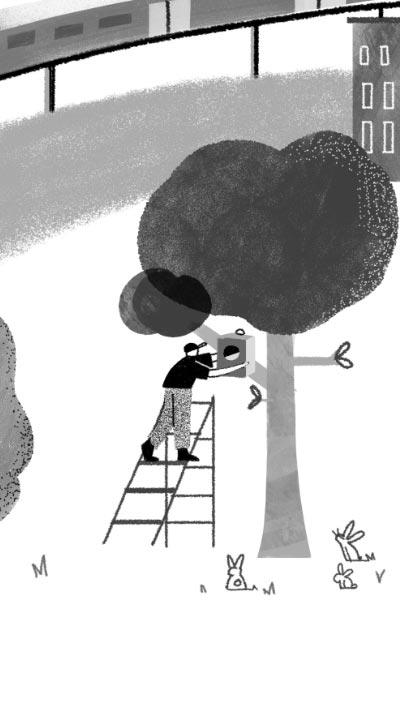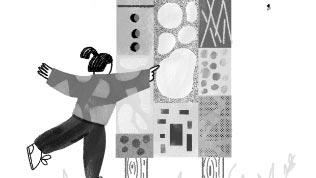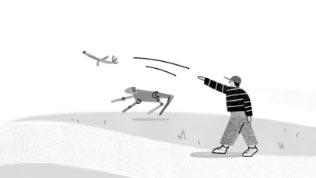Pandemics and climate change: Why animals are crucial
by Jeff Sebo
Unless we put animals at the centre of our health and climate policies, they won't save us.
Global health and environmental problems are interconnected, meaning that our solutions have to be interconnected too. There is growing interest in policy frameworks such as One Health, which attempts to integrate human, non-human and environmental health; and the Green New Deal, which attempts to integrate social, economic and environmental justice. But while these frameworks are major steps in the right direction, they don't go nearly far enough. They recommend minor reforms to industries that exploit and exterminate animals and contribute to global threats that affect humans and non-humans alike. If we want our health and environmental policies to be just and effective, we need to do much more than that.
The central failure of One Health, the Green New Deal and similar frameworks is that we view them through the lens of several standard biases. We have a spatial bias, which favours local impacts over global impacts. We have a temporal bias, which favours short-term impacts over long-term impacts. And we have a biological bias, which favours human impacts over non-human impacts. As a result, we continue to support industries that harm countless nonhumans in the short term and countless humans and non-humans alike in the long term, on the grounds that they appear to help some humans in the short term. If we want to break this cycle, then we need to break the biases that lead to it.
Take One Health: this policy framework recognises the linked nature of human, non-human and environmental health. It is widely accepted now that the more we study non-human health, the more we can learn about human health. And the more we protect non-human health, the more we can protect human health. For instance, if we want to increase resilience against pandemics, we can decrease antibiotic use in animal agriculture and increase testing and vaccinations for wild animals. Decreasing antibiotic use in animal agriculture would help preserve antibiotic effectiveness, while increasing testing and vaccination for wild animals would help us identify threats and prevent them before they emerge.
Similarly, the Green New Deal recognises the linked nature of social, economic and environmental justice. Climate change is a threat multiplier, introducing new threats while also amplifying existing ones, especially for the most vulnerable among us. If we want to increase resilience against these problems, we need to increase resilience not only against the new threats that these problems introduce, but also against the ordinary threats that they amplify, including hunger, thirst, illness and injury. Accordingly, proponents of the Green New Deal support universal access to healthcare, housing, income and other such goods as part of an environmental justice framework.
One Health and the Green New Deal are powerful frameworks. If we implemented their ideals together, promoting human, non-human and environmental health not least through the pursuit of social, economic and environmental justice, we would do a lot of good for humans, non-humans and the environment. We would substantially restrict, if not abolish, factory farming, deforestation and the wildlife trade, industries that all cause massive and unnecessary harm to non-human populations and substantially contribute to health threats such as pandemics, while factory farming and deforestation substantially contribute to environmental threats such as climate change as well.
Factory farming is a good example of how these issues are linked. This industry breeds, raises and kills more than 100 billion captive animals globally each year for food, and harms many humans each year too, particularly workers, consumers and local community members. It increases the risk of pandemics by consuming a lot of land, keeping animals with weakened immune systems in cramped, toxic conditions and administering high quantities of antibiotics. And it also increases the risk of climate change, again by consuming a lot of land and by emitting large quantities of carbon dioxide, methane and nitrous oxide into the atmosphere (the methane emissions of beef and dairy agriculture are particularly high).
Deforestation, similarly, causes harm to wild animals and Indigenous humans who rely on forested areas for food, income and shelter. It also increases the risk of pandemics by increasing contact between humans and wild animals and decreasing the biodiversity that serves as a buffer against the spread of zoonotic diseases. And it contributes to climate change by releasing stored carbon dioxide into the atmosphere and by reducing the planet's ability to capture and store carbon dioxide in the future. It should also be noted that, since animal agriculture is a leading contributor to deforestation, animal agriculture contributes to all these impacts indirectly; this is part of why the land-use impacts of food production are so important.
Finally, the wildlife trade causes massive and unnecessary harm to wild animals and contributes to pandemics in multiple ways. When humans bring wild animals from one region to another, we facilitate zoonotic disease spread within wild animal populations. And when humans keep and kill wild animals at live markets, we facilitate zoonotic disease spread within captive animal populations as well as between humans and non-humans. Whether or not COVID-19 originated in such a way, the fact that it might have done so should still serve as a cautionary tale.
These impacts make clear that if we were serious about promoting human, non-human and environmental health, in part through the pursuit of social, economic and environmental justice, then we would do much more than implement minor reforms to these industries. We would either substantially restrict or, ideally, abolish them. These industries are bad for human, non-human and environmental health and, insofar as they contribute to pandemics and climate change, which function as threat multipliers for vulnerable populations, they are also bad for social, economic and environmental justice. In short, there is no justification for supporting these industries if we are serious about any of these values.
The same applies to pandemic and climate change adaptation policies. If our health and environmental policy frameworks were fully inclusive, they would require us to consider the interests and needs of humans and non-humans alike in public policy. We would include animals in impact assessments, evaluating the expected impacts of policy proposals on human and non-human health and well-being. And we would use these multispecies impact assessments in policy decisions regarding research, education, social services, infrastructure and many other areas, since, in each case, we have the opportunity to improve the lives of humans and non-humans at the same time.
Consider, for example, what an inclusive approach to research and education might look like. We would invest heavily in research and education about what animals are like; what they need to live well; and how humans, non-humans and the environment interact. And we would train people to improve the lives of human and non-human animals rather than train them to exploit and exterminate non-human animals to satisfy short-term human interests. As a result, people would be more aware that non-human animals are subjects, not objects and that human and non-human fates are linked. And there would be greater enthusiasm for working in support of non-human animals, for the sake of humans and non-humans alike.
Similarly, consider what an inclusive approach to social-services policy might look like. We would invest heavily in employment opportunities for veterinarians and others who can improve the lives of non-human animals. We would consequently have more capacity to save non-human animals during human-caused disasters such as fires and floods. We would also increase non-human resilience, for instance by providing wild animals with food, vaccinations and, where possible and necessary, contraception, in order to maintain stable wild animal populations; we would reduce conflicts between humans and wild animals; and we would reduce the spread of zoonotic diseases between humans and wild animals.
Finally, consider what an inclusive approach to infrastructure policy might look like. As we rebuilt our cities and transportation systems, we would consider the needs of both humans and non-humans. We might install overpasses or underpasses on new transportation systems to reduce the risk of collisions with animals. We might install bird-friendly glass on new buildings and vehicles, to reduce the risk of collisions with birds. And we might establish more non-human habitats and employ more human caretakers in urban parks, to reduce the risk of conflict between human and non-human city dwellers. These kinds of changes all have the potential to be good for humans and non-humans alike.
As with our mitigation efforts, if we were serious about promoting human, non-human and environmental health, in part by promoting social, economic and environmental justice, we would be considering the interests and needs of everyone impacted by our policies, not only the interests and needs of (some) humans. Granted, if we took this more inclusive approach, then we would likely discover many cases where human and non-human needs diverge. But, as these examples illustrate, we would also likely discover many cases where (many) human and non-human needs converge and whatever we decided in the former, harder cases, we could at least agree about what to do in these latter, easier cases.
The upshot is that policy frameworks like One Health and the Green New Deal have a lot of potential, but that most proposals being made within these frameworks fall short of that potential. We have already seen three related reasons why they fall short. These frameworks, on standard interpretations, privilege local impacts over global impacts, short-term impacts over long-term impacts and human impacts over non-human impacts. This latter bias is particularly acute. Since we view non-human animals as having only (or, at least, primarily) instrumental value, we aspire to treat them better insofar as, and only insofar as, doing so appears to benefit us. We are perfectly happy to harm, kill and neglect them otherwise.
Granted, many people support conserving biodiversity, since they appreciate that biodiversity has aesthetic, cultural and ecological value. But there is a difference between protecting biodiversity and protecting individual animals. After all, what individuals need can diverge from what species and ecosystems need and individuals can suffer and die unnecessarily even when species and ecosystems survive and flourish. Thus, if we care about animals both individually and collectively, then we need to attend to their needs at both levels, by working not only to preserve biodiversity but also to improve the lives of individual non-human animals as much as we realistically can, given the limits of our knowledge and power.
Do we, in fact, care about animals enough to take action? There is evidence that we do. For instance, when the Australian bushfires killed an estimated three billion animals in 2019, humans donated millions of dollars for animal rescue. More generally, we all celebrate when a video emerges of a human saving an animal from a fence, fire, flood or other such threat. In these moments, we all feel what, in our more reflective moments, we know to be true: we have a duty to care for animals when we can, since their suffering is massive, neglected and, increasingly, caused by humans. We might well find that including animals in health and climate policy is more politically tractable than we think, as long as we frame the issue thoughtfully.
To be sure, a more inclusive One Health and Green New Deal would be even more demanding than the standard interpretations. It would require us to ask: what do animals need to live well? How might different policies impact them? How can we make policy decisions ethically in a world where, no matter what we do, many human and non-human animals will likely suffer and die as a result? These questions are both urgent and complex and it will take a lot of work to even start to answer them. Since we already feel overwhelmed by global health and climate issues when all we think about are the human impacts, we will likely feel even more overwhelmed when we think about non-human impacts too.
It is tempting, given how demanding One Health, the Green New Deal and other such frameworks are already, to think we should focus on humans now and expand to non-humans later. But this would be a mistake. There is a path-dependence to the way in which history unfolds. If we keep excluding animals now, our successors will be more likely to do the same, in part because they will be working with social, political, economic and ecological infrastructures that they inherit from us. Whereas if we start including animals now, then our successors will be more likely to keep including them - and will also be likely to have more knowledge and power to apply to this project.
With that in mind, I think that our current task is to look for opportunities to help at least some non-human animals in the short term, while building knowledge, power and momentum towards helping them more effectively in the long run. We can start by reducing support for factory farming, deforestation and the wildlife trade; increasing support for humane, healthful and sustainable alternatives to these industries; expanding research and education about animal health and welfare; increasing employment opportunities for animal caretaking; and updating `human' spaces such as cities and transportation systems to be more accommodating to animals. We can then learn from experience and decide what to do next.
Policy frameworks such as One Health and the Green New Deal are powerful visions for a just, healthful and sustainable global future. Human and non-human lives are interconnected and no policy framework that excludes 99 percent of our population, including and especially many of the most vulnerable among us, can be legitimate. So, if we want these policy frameworks to be just and effective, we need to consider non-human animals, not only for our sake, but also for theirs. And that means reducing our use of them and increasing our support for them, not only when that benefits us, but also, where possible, when it benefits them.

Jeff Sebo
Jeff Sebo is clinical associate professor of Environmental Studies, affiliated professor of Bioethics, Medical Ethics, Philosophy, and Law, and director of the Animal Studies MA Program at New York University. He is author of Saving animals, saving ourselves (OUP 2022) and co-author of Chimpanzee rights (Routledge 2018) and Food, animals and the environment (Routledge 2018). He is also an executive committee member at the NYU Center for Environmental and Animal Protection, an advisory board member at the Animals in context series at NYU Press, a board member at Minding Animals International, a mentor at Sentient Media, and a senior research affiliate at the Legal Priorities Project.



